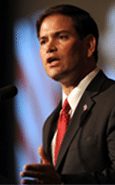The wireless industry’s thirst for spectrum remains a challenge for the federal government, which following years of apparent inactivity, is set to unleash more than 100 megahertz of new spectrum into the commercial space through auctions over an 18-month period.
Those efforts received a further boost this week as U.S. Senator Marco Rubio (R.-Fla.), who is also a member of the Senate Committee on Commerce, Science, and Transportation, introduced the Wireless Innovation Act, calling for the federal government to reallocate spectrum assets used by federal agencies for commercial use.
Specifically, the legislation requires the National Telecommunications and Information Administration to identify and reallocate 200 megahertz of spectrum for mobile use, including 140 megahertz for licensed, 40 megahertz for shared and 20 megahertz for unlicensed use, with those spectrum assets to be auctioned off beginning in 2018.
The legislation also “incentivizes” federal agencies to participate in reallocation efforts by allowing portions of the proceedings to “be made available for advance planning and enhanced efficiency, including research and development and cost and technical assessments on future reallocation of additional spectrum.” Rubio’s legislation also looks to promote the secondary spectrum market by speeding up the Federal Communication Commission review period for “routine license transfers.”
“The use of wireless broadband and Internet connected devices has caused an explosion of economic growth and innovation that was previously unimagined, and wireless traffic is projected to grow exponentially in the years ahead. In order to meet that demand and ensure that the [United States] continues to lead the world in wireless innovation and technology, we must ensure that the federal government uses its spectrum in an efficient and responsible manner, and we must free up additional spectrum for commercial use,” noted Rubio in a statement. “This legislation accomplishes both goals by directing NTIA to reallocate federal spectrum for commercial use. The Wireless Innovation Act will also provide transparency on the use and value of federal spectrum and inform the public on how federal entities use a scarce public resource. Passing the Wireless Innovation Act will grow our economy and ensure that consumers continue to enjoy the benefits of wireless technology.”
The federal government is currently working under a 2010 presidential memorandum that calls for freeing up 500 megahertz of spectrum by 2020, as well as a follow up 2013 memorandum that calls for more spectrum to be reallocated. NTIA recently released a report indicating that between the end of 2010 and September 2013, it had formally recommended or otherwise identified for potential reallocation up to 405 megahertz of spectrum to support wireless broadband use.
The FCC recently completed the H-Block auction, which included 10 megahertz of spectrum in the upper 1.9 GHz band, is planning to conduct the AWS-3 auction later this year and has the 600 MHz incentive auction on its docket for mid-2015.
Bored? Why not follow me on Twitter

Rubio introduces Wireless Innovation Act, spurs reallocation of gov’t spectrum
ABOUT AUTHOR
